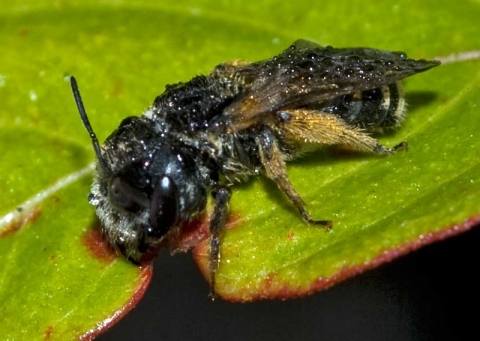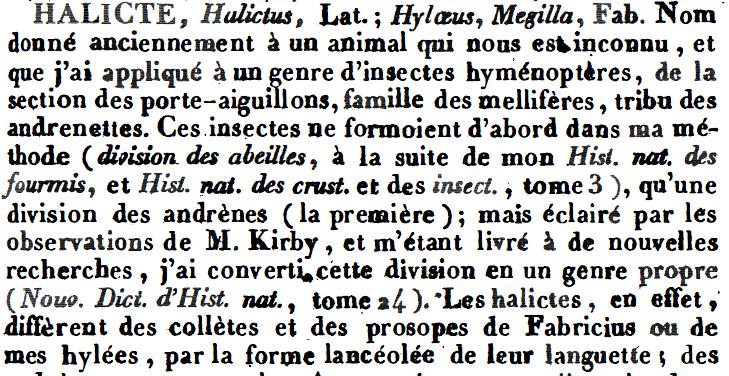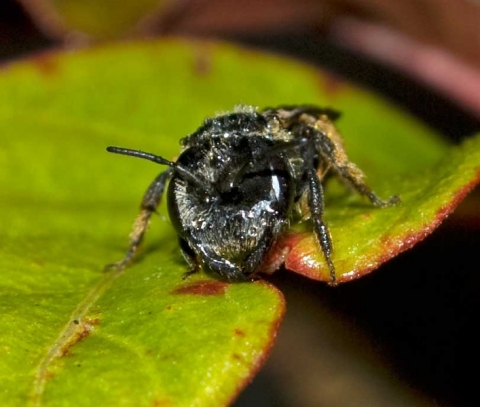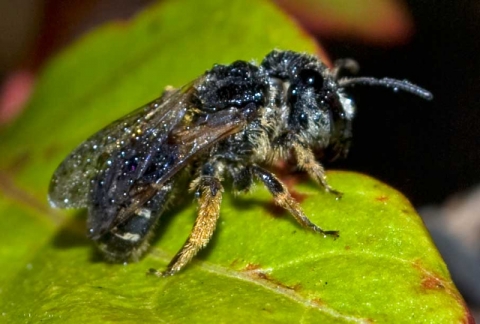A few recent mornings have been slightly foggy, which is unusual for Boca. It makes the air a bit more calm, which increases the photographic opportunities immensely. Unfortunately, this condition rarely lasts long enough for me to get the kids off to day care; by the time I return, the fog has burned off and the wind has kicked up.
Nevertheless, one recent foggy morning was so intriguing that I strapped Daniel into his kiddie backpack and went outside with a camera to have a look. And I was rewarded by the sight of a species of bee I hadn’t yet encountered on the property. Here it is, covered in the morning dew, resting (sleeping?) on the leaf of one of the firebush plants I have in the front yard:
(Kind of reminds me of Garfield falling asleep in his lasagna. The picture shows that this bee is attracted to dead/decaying vegetable matter; other users of bugguide have reported this behavior as well.)
The bee in question is Halictus poeyi, a species of sweat bee in the family Halictidae. You might recall that recently I found the first representative of the halictid bee family in the yard, Agapostemon splendens. Now that I’ve found a second species, I thought it appropriate to do a bit more research on this family.
I did not know what I was getting into.
H. poeyi is “primitively eusocial,” which means that the bee lives in colonies like the more “advanced” eusocial insects (ants, honeybees), but “workers” and “queens” look alike. (In technical terms that are well explained in this article, “primitively eusocial organisms show no morphological difference between reproductives and non-reproductives”). So species like this give us insight into the way eusociality developed in the insects, before the species developed morphological differences between castes.
Taxonomy
Here is some basic information about the family that I found from the UF website:
Halictid bees are found worldwide, but are especially abundant in temperate regions. […] In Florida, there are 44 species found within eight genera. These genera include: Sphecodes (10 spp. of parastic bees), Lasioglossum (17 spp.), Nomia (4 spp.), Agapostemon (2 spp.), Augochloropsis (3 spp.), Augochlora (1 sp.), Augochlorella (3 spp.) and Halictus (4 spp.) (Pascarella 2006). Most of these species are also common throughout the eastern United States.
You should never get all your information from one source, whether in politics or taxonomy. The site above says 44 Florida species; John Pascarella’s “Bees of Florida,” which was used in preparing the above page, says there are 66 taxa of Halictidae in the state. (Taxa might include subspecies, whereas “species” means only full species, which might explain the discrepancy.)
However many sweat bees there are in Florida, though, this particular species has had an interesting taxonomic history. It was first described by Count LePeletier in 1841 (Histoire naturelle des insectes: Hyménoptères, t. II) as Halictus poeyi, but many workers considered it to be the same species as H. ligatus, first described by Thomas Say in 1837 (Boston Journal of Natural History, 1(4)393-416, published posthumously).
Recently, though, (as a result of this article from 1996) it regained full species status, because unlike H. ligatus, the population of H. poeyi in south Florida is “continuously brooded and multivoltine” (that is, they rear young year-round, with more than one generation per year). The paper was written after an experiment comparing two different behavioral populations of H. ligatus revealed something interesting.
We would like to comment on the unexpected nature of this discovery. Halictus ligatus is one of the most abundant and readily identifiable bees in North America. It certainly is known as a variable species, but this is not surprising given its large geographic range, encompassing a wide range of aridities and altitudes, as well as the additional complexities caused by allometric variation and size-based caste differentiation. Indeed, morphological variation in H. ligatus has been the subject of a Ph.D. thesis (Kirkton, 1968) and no obvious disjunction was detected. Although other species groups in the Halictini are well known as being taxonomically “difficult”, there has never been any doubt that Halictus ligatus was a “good” species. It seems probable that such ease of identification has discouraged the critical examination which taxa that are “known” to be “difficult” receive. This situation appears to be not uncommon in bees (Packer and Taylor, submitted) and warrants investigation in other taxa.
The original impetus for this study was the investigation of genetic variation between behavioral types. We found no evidence for any genetic differentiation across the behavioral boundary in Central Florida, where populations appear to be panmictic with high genetic identities. However, we did find evidence of species level differentiation much further north. We now need to investigate whether behavioral or phenological differences exist between the two species in areas of sympatry.
Conservation Value
One of the reasons I’m interested in native pollinators is because of their importance to native plants, and via that entree, to birds and other native fauna. Theodore Mitchell emphasized the conservation value of the native bee fauna back in 1960:
The native bee fauna probably is much more important than the honey bee in the conservation of wi!d life and game management, even though many wild colonics of honey bees occur in most wooded areas. Game birds, such as quail and turkey, the song birds, and many of the mammals depend to a considerable extent upon the fruits of various native plants, and such plants have a much closer ecological relationship to the native bee fauna than have most crop plants.
Etymology
The etymology of taxonomic names of bees is nowhere near as secure as that of spiders (for which see Chapter 73 of AAS, Spiders of North America: An Identification Manual); I actually had to find the origin of the specific name (poeyi) by searching other taxa. I finally found an 1891 report from the United States Commission of Fish and Fisheries (thank you Google Books!) that included an etymological note about a certain type of fish (Halichoeres poeyi) that was named after 19th-century Cuban naturalist Felipe Poey. I’m fairly confident that this bee, native to Cuba as well as south Florida, is also named after him.
As far as the generic name, Halictus, I’m not really sure what it’s named for. My normally reliable, if far from comprehensive, Composition of Scientific Words (Roland Wilbur Brown) just says “a genus of bees; see bee“. Under “bee,” I find “NL. halictus, m. a genus of bees; Halictus inconspicuus (a bee).” It’s nice to know that the gender of the word is masculine, but I was hoping for some derivation. No dice. Greek halis (αλς) means sea; not much help there. There used to be a lepidopteran genus, Halias, but that is no longer valid (the name is now Pseudoips); perhaps the bees were named after the moths? The OED? No entry, in either the 2nd ed. or the supplement. American Heritage? No entry. New Century dictionary? At least there’s an entry, but all it tells me is that the genus was named in 1804 by Latreille. Nice, but not as informative as I’d like. (Latreille introduced the idea of the “type species“, a species to which the name of a genus is firmly attached. He also favored the naming of genera after one of the species in the genus instead of after some defining feature of the group.
Long story short, after A LOT of searching, I found a reference in an online French etymological engine to an article in an early-19th-century dictionary of natural history. Then, after A LOT more searching through Google Books results, I found volume 14, and the substantial article Latreille wrote for that book. Here’s a screenshot of the beginning of the article, just for flavor:
The point of that long foray into researching the genus name is that the person who named the genus had no idea what the name meant, either! The name apparently comes down to us from antiquity: it was “formerly given to an unknown animal” according to Latreille. So all we can say about Halictus is that the name “means” a genus of sweat bee.
More Pictures
After that dose of French, perhaps you’ll appreciate these last few pictures of the bee a bit more.
The head shot:
And the other side of the body:
In both of the full-body shots you can see the fine golden hairs on the rearmost pairs of legs that enable this bee to carry the pollen it needs back to its nest. Such a pretty little thing, really. I’ve not seen it in the garden since that foggy morning, but I’m keeping my eyes peeled for it.
References
Carman, G. M. and L. Packer. (1996). A Cryptic Species Allied to Halictus ligatus Say (Hymenoptera: Halictidae) Detected by Allozyme Electrophoresis. Journal of the Kansas Entomological Society, 69(4 Suppl.) 168-176.
Latreille, A. (1841). Histoire naturelle des insectes: Hyménoptères, t. II.
Mitchell, T.B. (1960) Bees of the eastern United States. I. Technical bulletin (North Carolina Agricultural Experiment Station), 141, 1-538.
Plowes, N. (2010) An Introduction to Eusociality. Nature Education Knowledge 1(11):7.
Say, T. (1837). Descriptions of new species of North American Hymenoptera. And observations on some already described. Boston Journal of Natural History, 1(4):209-418.




